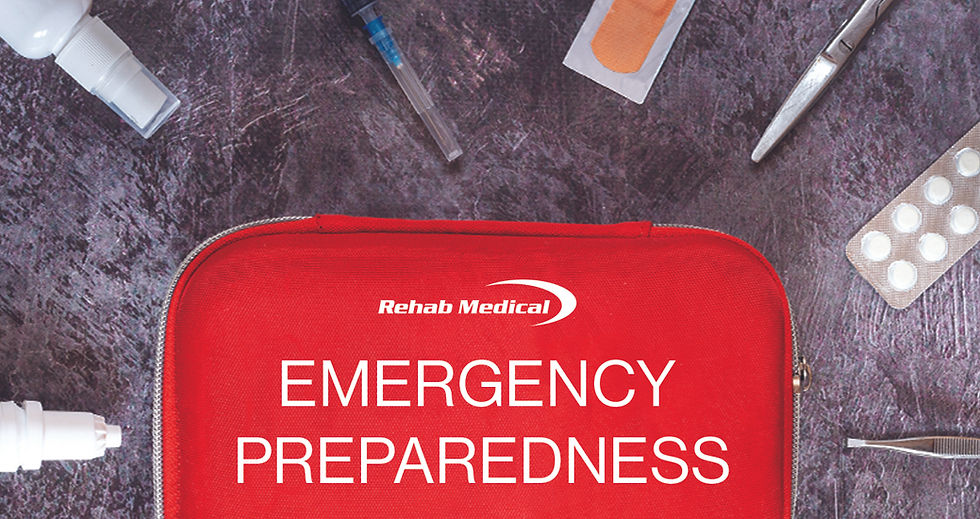How to Use Proper Etiquette When Helping Someone with a Disability
- Rehab Medical

- Jun 28, 2023
- 3 min read
Updated: Sep 1, 2023

Currently, in 2023, approximately 27% of U.S. citizens have some form of disability, according to the CDC, making it the largest minority group in the country. Regardless of how common disabilities are, people still express negative stereotypical behavior. Whether it's poor communication or misconceptions, others often struggle when effectively communicating to someone with a disability.
To ensure you are being considerate and offering appropriate assistance, the Rehab Medical team has put together a guide of five ways to provide proper etiquette to someone with a disability who may need help.
Identifying someone with a disability
According to the Equality Act, a disability is a physical or mental impairment substantially affecting your ability to carry out normal day-to-day activities. Disabilities are classified into types that are visible and hidden.
Common hidden disabilities include learning difficulties, mental health, speech, visual or hearing impairments, and common physical disabilities include autism, down syndrome, Cerebral Palsy, and Muscular Dystrophy. People are affected differently; without visible evidence of a hidden disability, it is difficult to see what someone is going through.
Disabilities can cause pain, exhaustion, and isolation, so when you offer to assist an individual, be aware, show care and gain approval before helping.
Confirm approval
If you see a stranger in public with a disability who is struggling, your first instinct may be to jump in and help. However, you may only worsen the situation if you don't know the person's specific needs or intentions, given that not all disabilities are apparent.
If someone seems to need help, it doesn't mean they want yours. Assisting without permission can cause fear and unwanted tension. To prevent these feelings from occurring, ask the individual before jumping in to help. If the individual agrees, ask for specific directions on how to help.
If a service animal is present, do not touch it without permission. These animals are highly trained and well-behaved, so it is best to proceed cautiously to avoid mishaps.
Ask questions
It's okay to ask questions! People are often skeptical of asking questions as they do not want to call attention to someone's disability. Avoiding an obvious question can cause more attention to the issue than simply addressing it. It's necessary to ask questions if the situation calls for it. Feel free to ask if you need clarification on something. The individual would appreciate it if you did!
Show respectful behavior
When interactions begin, always consider the person first, not the disability. People often feel they should speak slower or louder, especially if they're interacting with someone who is deaf or hard of hearing, but this can be seen as offensive. Speak in your normal voice and tone.
If you're interacting with someone hard of hearing, look directly at them so they can read your lips and follow other visual cues. Additionally, be sure to avoid interrupting while they are communicating with you. When the individual or care assistant is finished speaking, it is respectful to share your thoughts afterward.
It's okay to touch someone's mobility equipment if they have permitted you to do so. However, if they haven't, leaning or moving mobility aids could result in safety issues if the individual is unaware of such movements. It is best to assist carefully after receiving approval so there is no risk of an accident.
Communicating with a care assistant
Make eye contact if you speak to a care assistant or an interpreter and talk to them directly. They are professional and will ultimately know what the right decisions will be. Make sure to be flexible and patient when communicating with a care assistant.
While a disability plays a part in someone's life, it does not define who a person is. Everyone deserves to be treated with respect, and people with disabilities are no different. Are you ready to help those who accept assistance when the situation arises?
Resources
- https://blog.vancity.com/6-ways-can-support-people-disabilities/ - https://content.govdelivery.com/accounts/UKEASTBOURNE/bulletins/2a27b55
- https://www.dhs.state.il.us/page.aspx?item=32276
- https://www.huffpost.com/entry/disabled-people-want-nondisabled-friends-to-know_l_604808d5c5b672fce4e8f436
- https://www.nln.org/education/teaching-resources/professional-development-programsteaching-resourcesace-all/ace-d/additional-resources/communicating-with-people-with-disabilities-e030c45c-7836-6c70-9642-ff00005f0421
- https://udservices.org/types-of-service-dogs/
- https://www.who.int/news-room/fact-sheets/detail/disability-and- health#:~:text=Persons%20with%20disabilities%20have%20twice,disabilities%20face%20many%20health%20inequities.




Comments